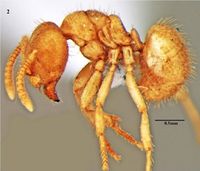Pseudolasius zamrood
| Pseudolasius zamrood | |
|---|---|

| |
| Scientific classification | |
| Kingdom: | Animalia |
| Phylum: | Arthropoda |
| Class: | Insecta |
| Order: | Hymenoptera |
| Family: | Formicidae |
| Subfamily: | Formicinae |
| Tribe: | Lasiini |
| Genus: | Pseudolasius |
| Species: | P. zamrood |
| Binomial name | |
| Pseudolasius zamrood Akbar, Bharti & Wachkoo, 2017 | |
The specimens of this rare species were handpicked from Thanikkudy region of Periyar tiger reserve; a primary, undisturbed tropical moist evergreen forest. The specimens were collected by dislodging a big stone near a river side. The area is situated at 1003 meters elevation. It is a shady place with little sunlight penetration.
Identification
Akbar (2017) - Workers (majors and minors) Body with profuse pilosity; numerous erect hairs on head, scape, mesosoma, and legs, with appressed pubescence underneath; extremely reduced eyes; short scapes; anterior clypeal margin truncate medially; mandibles with four distinct teeth; gyne with subquadrate head having broadly emarginate posterior margin; males with oval head; parameres paddle shaped with rounded tips; long and tubular cuspis; weakly anvil shaped digitus.
The species appears distinct with its extremely reduced eyes. The new species is closest to Pseudolasius typhlops from the Philippines. However P. typhlops has a truncated anterior clypeal margin at the middle lobe, the scapes are relatively short and the propodeum has a relatively narrow dorsum in lateral view.
Keys including this Species
Distribution
Distribution based on Regional Taxon Lists
Oriental Region: India (type locality).
Distribution based on AntMaps
Distribution based on AntWeb specimens
Check data from AntWeb
Countries Occupied
| Number of countries occupied by this species based on AntWiki Regional Taxon Lists. In general, fewer countries occupied indicates a narrower range, while more countries indicates a more widespread species. |

|
Estimated Abundance
| Relative abundance based on number of AntMaps records per species (this species within the purple bar). Fewer records (to the left) indicates a less abundant/encountered species while more records (to the right) indicates more abundant/encountered species. |

|
Biology
Akbar (2017) - The species appears to be distinct among regional species of the genus, with its extremely reduced eyes size both in major and minor workers. This character state is also exhibited by some Pseudolasius species from Afrotropical and Indo-Australian regions. These species represent rare hypogaeic evolutionary lineages and are quite different from the more common, larger, presumably epigaeic species (LaPolla, 2004). This is the first record of the genus from South India.
Castes
Worker
'Minor
 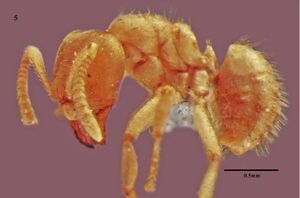 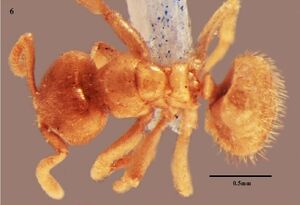
| |
| . | |
Queen
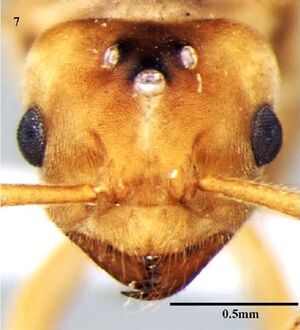 
| |
| . | |
Male
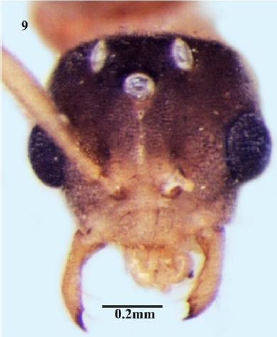 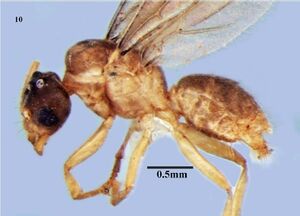
| |
| . | |
Nomenclature
The following information is derived from Barry Bolton's Online Catalogue of the Ants of the World.
- zamrood. Pseudolasius zamrood Akbar, Bharti & Wachkoo, 2017: 134, figs. 1-10 (w.q.) INDIA.
Unless otherwise noted the text for the remainder of this section is reported from the publication that includes the original description.
Description
Worker
(Holotype in brackets): HL (0.81) 0.71-0.83; HW (0.77) 0.69-0.77; SL (0.50) 0.50-0.55; PW (0.51) 0.42-0.55; PrFL (0.67) 0.59-0.71; PrFW (0.17) 0.14-0.20; WL (1.25) 0.77-1.31; GL (1.13) 1.01-2.04; TL (3.18) 2.49-4.18. Indices: CI (95) 92.77-97.18; SI (64) 71.42-72.46 (n=10).
Roughly rectangular head with strongly emarginate posterior margin in the middle; rounded postero-lateral corners; lateral sides sub-parallel and gently converging anteriorly; frontal carinae, nearly parallel with lateral sides of head; almost rectangular clypeus, protruding in the middle; bluntly toothed anterolateral corner; antennae 12-segmented; short scape, reaching 3/4th of occipital margin of head; mandibles with four distinct teeth, extremely reduced eyes, rudimentary represented by small pigmented dots both in major and in minor workers.
In lateral view, relatively flat promesonotum; strongly developed metanotal groove; distinct metanotal area, well developed and depressed; slightly elevated propodeum, convex and narrow dorsal face, with sides diverging basally; declivity steep, about two times as long as dorsal face; spiracle rounded propodeal; low scale like petiole, with longer posterior face than anterior face, transverse dorsum, ventral projection prominent and inclined forward; first gastral segment with transverse anterior face.
Body covered with abundant pilosity throughout; head and gaster with abundant appressed pubescence, mesosomal dorsum with several, erect hairs sparced throughout; mandible with 4-5 short curved setae near masticatory border; anterior clypeal margin with 3-5 erect setae, anteriorly directed; fringe of short 1-2 setae also present towards mandibular base; gaster with erect hairs throughout the surface.
Body with a prominent yellow opaque cuticle with micro-reticulate, superficial sculpture.
Body uniformly dark yellowish brown in colour.
Minor workers similar to major workers with the following differences; subquadrate head with posterior margin having less distinct strongly emargination in the middle; longer antennal scapes reaching 4/5th of occipital margin of the head; in lateral view, convex promesonotum. Although entire next series of the new species was collected under the stone, without any further specimens available at that time, there is still possibility that maximum sized major workers may still be discovered. The larger available specimens collected are here treated as major workers. The distinction of castes among worker specimens in the genus is difficult to make with blending of the major and minor castes (LaPolla, 2004).
Queen
HL 1.36, HW 1.24, SL 0.77, EL 0.22, PW 1.37, PrFL 1.07, PrFW 0.20, WL 1.88. Indices: CI 91; SI 62 (n=1).
Gyne similar to worker with usual differences for the caste, including three ocelli, complete thoracic structure and wings; sub-quadrate head with broadly emarginate posterior margin; anterior clypeal margin transverse; scape surpass posterior occipital margin by about 1/5th its length; indistinct propodeum; feebler body sculpture than in worker; darker colouration; pubescence abundant on all the body; gyne damaged without abdomen.
Male
HL 0.58-0.61, HW 0.55-0.58, SL 0.44-0.46, EL 0.19, PnW 0.63-0.65, PFL 0.58-0.61, PFW 0.13-0.15, GL 1.21-125, WL 1.01-1.20, TL 2.08. Indices: CI 98.21-100; SI 79.31-80.00 (n=3).
Oval head, as long as wide excluding large compound eyes; sub-globulose eyes, bulging, projecting well beyond head outline in full-face view; three prominent ocelli present; transverse anterior clypeal margin; antennae 13-segmented, filiform; long scape, surpass posterior occipital margin by about three-tenths their length; slender mandible; reduced dentition, with prominent apical and apico-basal teeth and 1-2 denticles in-between. Broad mesosoma; in lateral view, strongly convex mesoscutum while the mesoscutellum is weakly convex; distinct propodeum; petiole as in worker; elongate gaster; parameres paddle-shaped with rounded tips, turning slightly inwards toward midline of body posteriorly; long setae extending off parameres; long and tubular cuspis, bent toward digitus; weakly anvil-shaped digitus; curved outward and covered with short peg-like teeth; penis valves projecting forward.
Body mostly smooth and shiny; erect setae shorter and sparse.
Colour light yellow, head mostly brownish.
Type Material
Holotype (major worker): India: Kerala, Periyar tiger reserve, Thanikkudy, 9o.30`N, 77o.16`E, 1003m, 15 Oct 2011, hand picking (coll. Shahid A. Akbar). Paratypes: 12 workers (5 major and 7 minor workers), 1 gyne and 4 males (one with damaged abdomen), with same data as holotype. Holotype and 13 paratypes deposited in Punjabi University Ant Collection, 4 paratypes will be deposited in The Natural History Museum.
Etymology
The species epithet is Arabic for ‘precious stone’ in reference to habitat of the new species.
References
References based on Global Ant Biodiversity Informatics
- Akbar S. A., H. Bharti, and A. A. Wachkoo. 2017. Discovery of remarkable new ant species of the genus Pseudolasius Emery (Hymenoptera: Formicidae) From Western Ghats of India. Sociobiology 64(2): 133-137.
- Dad J. M., S. A. Akbar, H. Bharti, and A. A. Wachkoo. 2019. Community structure and ant species diversity across select sites ofWestern Ghats, India. Acta Ecologica Sinica 39: 219–228.
